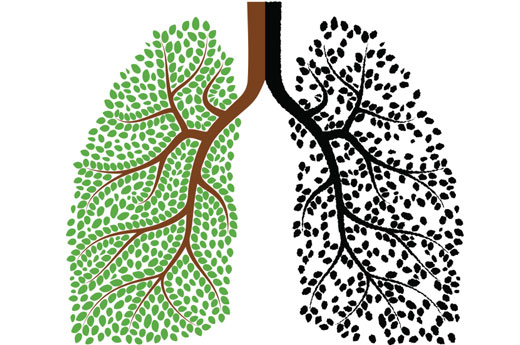by guest blogger Isaac Eliaz, MD, MS, LAc, integrative medicine pioneer
Breathing is essential to life. And because it’s automatic, we don’t have to focus on breathing the way we do eating or walking, so we rarely think about it. But maybe we should. Taking in oxygen is fundamental to good health, and for all the time and effort we spend on our diets, it’s interesting that we spend so little on breath.
Though Western philosophy does not devote much mental energy to considering the breath, our friends in the East have a different take. Chinese, Tibetan, and other Eastern traditional healing systems have long recognized the relationship between breath and body. Breathing connects us with our environment. The process of breathing—and especially conscious, meditative breathing—allows us to receive the nourishment of oxygen and experience release from our physical, mental, and emotional burdens.
When we inhale, we take in energy and connect our bodies to the universe. That energy is vital for our well-being. In fact, oxygen energizes our cells. The other side of the process, exhaling, removes carbon dioxide. In other words, breathing maintains balance.
The Value of Deep Breathing
When we are very hungry, we need to eat more. By the same token, when our bodies are deprived of oxygen, we need to breathe deeply. This is most evident after intense exertion, say, a short sprint.
But deep breathing shouldn’t be reserved for exercise alone. When we don’t inhale deeply enough, we decrease the amount of oxygen our breath delivers to our cells, reducing their ability to produce energy. In addition, deeper breathing removes more carbon dioxide, along with other potential toxins. Respiration also balances your body’s pH, reducing the acidity that can impair immunity and other functions.
When incorporated into meditation, deep, conscious breathing reduces inflammation, improves autonomic nervous responses, boosts circulation, and decreases cortisol levels, all of which affect our metabolism of glucose.
Deep breathing helps the heart, too. Reduced blood oxygen forces the heart to pump more; increased oxygen has the opposite effect. In addition, deep breathing reduces oxidative stress, enhances vital energy, and improves cognition.
Now Breathe
Over the last century, our breathing volume has decreased. This is partially due to modern work life, which puts us at computers rather than in fields. Physical demands are lower, plus we’re often hunched over, which restricts lung capacity.
Normally, we breathe in about half a liter, or two cups, of air. But our capacity is much larger. On a truly deep inhalation, we can take in about three liters. We have gotten into the habit of taking shallow breaths. How do we break out of it?
The answer is mindfulness. If we are aware of our body, we naturally take deeper breaths. The most obvious choice for enhancing mindfulness is meditation, but other disciplines, such as yoga and tai chi, also rely on harnessing the breath. These practices bolster the immune system on the genetic level; they improve cardiovascular health, grow connections between neurons, and decrease anxiety and depression.
Engaging the diaphragm, the muscle between the chest and the abdomen, is key to deepening the breath. All too often, we breathe with our abdomen. By working to engage our diaphragm, as well, we improve our ability to take in more air. Add to that a slower exhalation. Give the body time to exchange oxygen for carbon dioxide. Then exhale.
How we bring the air in is also important. Inhaling through the nostrils warms and moisturizes the air and filters out bacteria, viruses, dust, and other foreign objects. The nose pre-processes air for our lungs; breathing through it can reduce allergies and other respiratory ailments.
While Western medicine does not recognize the difference, many ancient systems understand the role each nostril plays and the significance of alternating nostrils during breathing exercises. Different emotional, psychological, and spiritual qualities are associated with each nostril: the left relates to aversion and anger; the right is associated with desire and attachment. By alternating nostrils, we can help restore emotional balance, and research shows that this type of breathing can support relaxation and improve our cardiorespiratory performance.
I think the first step toward developing a sound breathing regimen is to change our attitudes towards the breath. If we think of oxygen as a key nutrient, the way we think of vitamin C or iron, we’ll naturally want to inhale as much as possible. Given the benefits to immunity, cardiovascular health, sugar metabolism, and cellular energy, it just makes sense to breathe deeply. Do it now, and you’ll feel the immediate effects. Just think of the long-term benefits.
 Isaac Eliaz, MD, MS, LAc, integrates Western medicine with his extensive knowledge of traditional Chinese, Tibetan, Ayurvedic, homeopathic, and complementary medical systems. With more than 25 years of clinical experience and research, Dr. Eliaz has a unique holistic approach to the relationship between health and disease, immune enhancement, detoxification, and cancer prevention and treatment. For more information about his work, visit dreliaz.org.
Isaac Eliaz, MD, MS, LAc, integrates Western medicine with his extensive knowledge of traditional Chinese, Tibetan, Ayurvedic, homeopathic, and complementary medical systems. With more than 25 years of clinical experience and research, Dr. Eliaz has a unique holistic approach to the relationship between health and disease, immune enhancement, detoxification, and cancer prevention and treatment. For more information about his work, visit dreliaz.org.





Thank you, this information comes just as I personally need it. I’ve found myself getting headaches and feeling lightheated, and I have wondered if it’s because I’m not breathing deep enough! Now here is my answer. I’m going to start consciously breathing deeper and see if it helps! Thanks again!